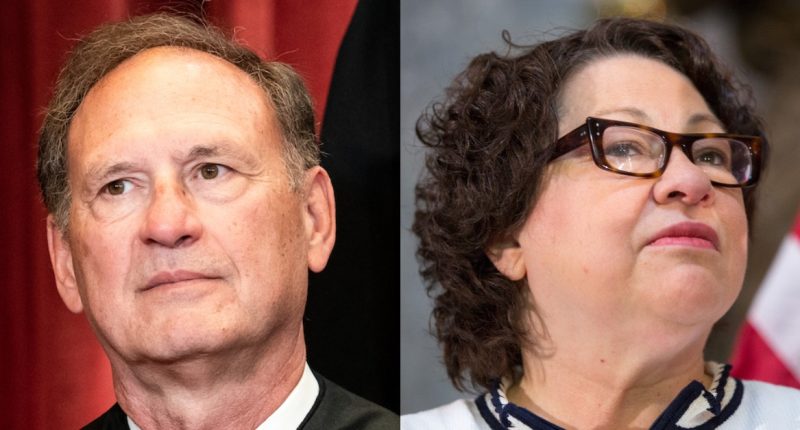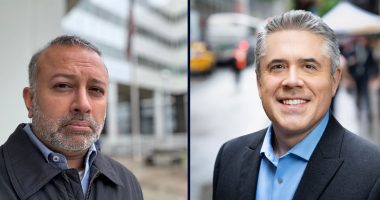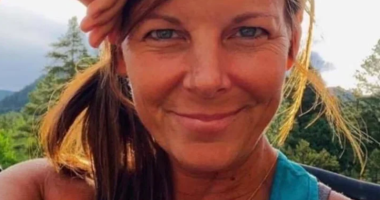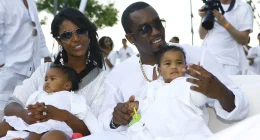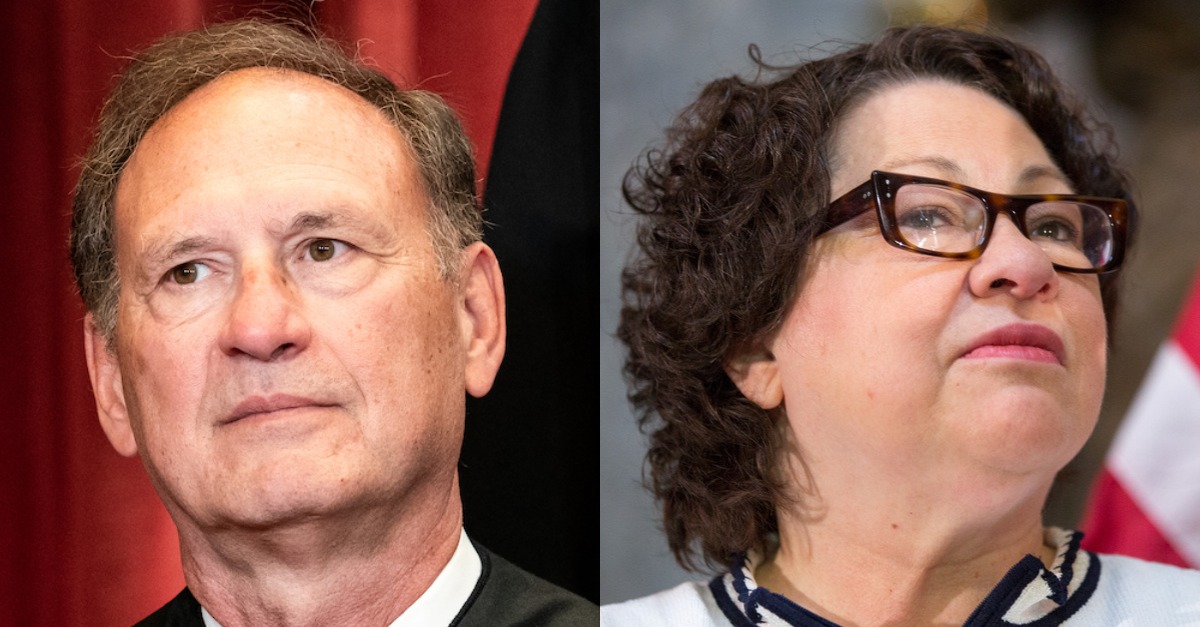
Left: WASHINGTON, DC – APRIL 23: Associate Justice Samuel Alito sits during a group photo of the Justices at the Supreme Court in Washington, DC on April 23, 2021 (Erin Schaff-Pool/Getty Images). Right: WASHINGTON, DC – MARCH 18: U.S. Supreme Court Justice Sonia Sotomayor participates in an annual Women’s History Month reception hosted by Pelosi in the U.S. Capitol building on Capitol Hill in Washington, D.C. (Photo by Allison Shelley/Getty Images)
The justices of the Supreme Court have signaled a likely split when they rule in a case brought by a group of Maryland parents who wish to have their children opt out of classroom instruction that includes storybooks with LGBTQ+ themes.
In the case, Mahmoud v. Taylor, the Court’s conservative majority appeared likely to side with parents who assert a constitutional right to keep their children from the instruction.
The plaintiffs in the case are Muslim, Roman Catholic, and Ukrainian Orthodox parents with children in Montgomery County public schools — a district about 30 miles north of Washington, D.C., which has been recognized as the most religiously diverse county in the United States. The parents, represented by the Becket Fund for Religious Liberty, are challenging a 2022 decision by the school board related to storybooks with young LGBTQ+ characters in its language arts curriculum.
One book at issue describes the story of a girl attending her uncle’s same-sex wedding, while another book, “Pride Puppy,” tells the story of a puppy that gets lost during an LGBTQ+ Pride parade. The school board initially allowed parents to opt out of having their children receive instruction using the books, but later changed course and no longer allowed the opt out. The group of six parents sued and argued that their First Amendment rights to freely exercise their religion had been violated, because the school board’s refusal to allow and opt out stripped them of their ability to instruct on or expose their children to issues of gender and sexuality according to their respective faiths.
The Court’s liberal wing — Justices Elena Kagan, Sonia Sotomayor, and Ketanji Brown Jackson — were overtly skeptical about the idea of adopting a broad rule that allowed parents to opt out of instruction that merely exposes children to material to which parents object. Exposure, they argued, is different from coercion.
In a question posed to attorney Eric Baxter, who argued for the parents, Kagan summed up, “in terms of opt-out, you’re basically saying opt-out for anything.”
“[I]t’s really the parents that get to decide,” Kagan continued, referring to the Baxter’s position. “It doesn’t matter the kid’s age, doesn’t matter sex, not sex … You know, if, like, just looking at a book would be in conflict with religious principles, that would be enough?”
Sotomayor pushed the argument a step farther.
“I’m sorry, I — I have a whole list of cases where parents have objected to ‘biographical … material about women who have been recognized for achievements outside of their home’ because some people believe women should not work,” the justice offered.
“So, too, parents have objected to teachers reading books featuring divorce, interfaith marriage, or immodest dress,” she continued.
“For reality’s sake, you see interfaith couples all the time walking around,” Sotomayor also said. “You see interracial couples walking — walking around. You see women on this Court in positions of work outside the home.”
Jackson, too, pushed back on the idea of opt-outs, posing the example of a gay teacher with a wedding photo on their desk.
“Do we have opt-out provisions for children in that situation?” Jackson asked.
The Court’s conservative wing, however, was clearly of a different mind.
Justice Samuel Alito was concerned that the books were sending a “clear moral message” that favored acceptance of same-sex marriages:
Yeah, the book has — the book has a clear message, and a lot of people think it’s a good message, and maybe it is a good message, but it’s a message that a lot of people who hold on to traditional religious beliefs don’t agree with. I don’t think anybody can read that and say, well, this is just telling children that there are occasions when men marry other men, that Uncle Bobby gets married to his boyfriend, Jamie, and everybody’s happy and everything is — you know, it portrays this — everyone accepts this except for the little girl, Chloe, who has reservations about it. But her mother corrects her: No, you shouldn’t have any reservations about this. As I said, it has a clear moral message.
When Sotomayor interrupted to clarify the challengers’ argument, Alito snapped, “Can I finish, please?”
He then reiterated, “It has a clear moral message. And it may be a good message. It’s just a message that a lot of religious people disagree with.”
Justice Amy Coney Barrett seemed to share Alito’s concerns. In an exchange with attorney Alan Schoenfeld, who represented the school district, Barrett argued that teaching the books amounts to more than simply exposing children to the themes included.
“It’s saying: This is the right view of the world. This is how we think about things,” said Barrett. “This is how you should think about things. This is like 2 plus 2 is 4.”
Justice Neil Gorsuch apparently agreed. While he allowed that “we live in a pluralistic society, period,” Gorsuch argued that instruction that “some people think X, and X is wrong and hurtful and negative” would amount to “more than exposure.”
The justices also disagreed about the practicality of allowing some families to opt out of portions of the curriculum. Schoenfeld argued it was not possible for school officials to make arrangements for the space, supervision, and alternate instruction needed for the many students who would opt out, but several justices were unconvinced.
“The plaintiffs here are not asking the school to change its curriculum,” Alito commented, then asked: ” Why isn’t that feasible? What is the big deal about allowing them to opt out of this?”
Barrett had similar questions.
“How could it be that the opt-out policy became unmanageable if they weren’t part of the instruction?” she asked. “Because, if they were just on the shelf and the parents sought an injunction saying we don’t want to be taught, then, presumably, that’s no big deal.”
Justice Brett Kavanaugh was similarly confused.
“I’m not understanding why it’s not feasible,” he said. “The county had an opt-out. You said every other school board in the country has opt-outs for all sorts of things. The county has opt-outs for all sorts of things. The other Maryland counties have opt-outs for all sorts of things. And yet, for this one thing, they changed in mid — midyear and say no more opt-outs. I’m just not understanding feasibility.”
Schoenfeld warned that granting parents a constitutional right to opt out in this situation could have sweeping consequences.
“[O]nce you constitutionalize it, I think you’ll see an entirely different generation of challenges to school curriculum,” Schoenfeld said.
You can listen to the full oral arguments here.
Love true crime? Sign up for our newsletter, The Law&Crime Docket, to get the latest real-life crime stories delivered right to your inbox.
